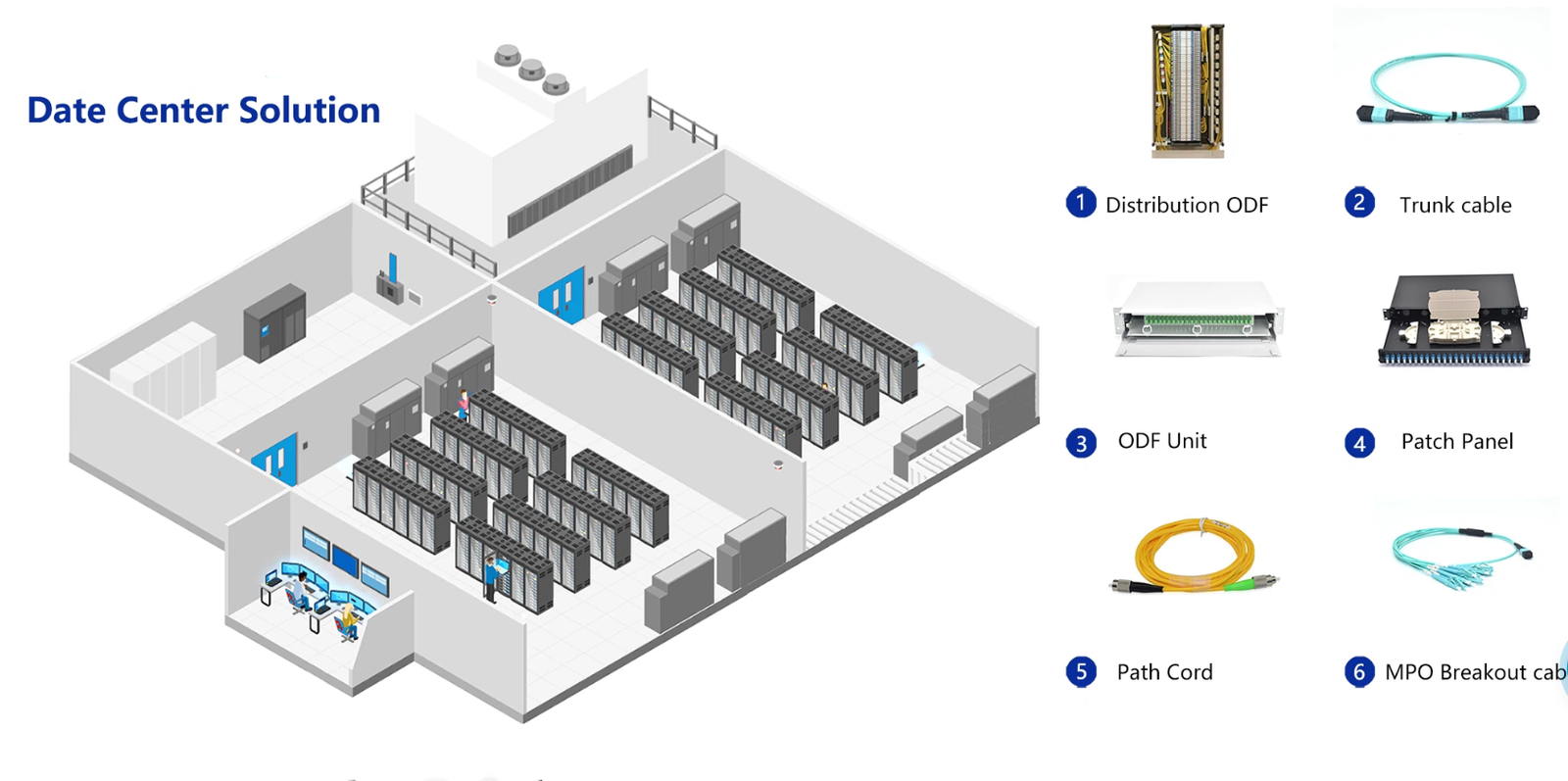Fiber Optic Products in Data Centers
Fiber Optic Products Within Data Centers As cloud computing, big data, artificial intelligence (AI), and 5G technology continue to develop rapidly, contemporary data centers require high-speed, low-latency, and high-availability networks. Because of its high bandwidth capabilities, low loss, resilience to electromagnetic interference (EMI), and expandable nature, fiber optic communications have become the predominant technology for data center interconnection.

A good fiber network for a data center consists of multiple important fiber components, including:
1. Fiber Optic Cables: The Backbone of Data Transmission
Single-Mode Fiber (SMF) – Best for long-distance transmission (up to 40km) with minimal attenuation.
Multi-Mode Fiber (MMF) – Cost-effective for short-range transmission (typically within 400m).
2. MTP/MPO Cables & Connectors: High-Density, Rapid Deployment Solutions
12F MPO – Suitable for 40G/100G connections.
24F MPO – Ideal for 100G/400G high-density networks.
MTP-LC Breakout Cables –These are Used to connect MPO backbone cables to LC interface switches and transceivers.
3. Fiber Patch Cords: High-Speed Interconnects Between Devices
LC-LC / LC-SC Patch Cords – Used for connecting transceivers and patch panels.
MTP/MPO Patch Cords – Designed for high-density, high-speed transmission.
OM3/OM4/OM5 Patch Cords – Multi-mode fiber patch cords for short-distance 40G/100G/400G connections.
4. Optical Transceivers: Converting Electrical to Optical Signals
SFP+ (10G) – Ideal for 10G Ethernet connections.
QSFP+ (40G) – Supports 40G transmission, typically using MPO/MTP interfaces.
QSFP28 (100G) – Suitable for 100G high-speed Ethernet.
QSFP-DD (400G) – Next-generation transceiver for ultra-high-speed 400G transmission.
5. Fiber Patch Panels: Efficient Cable Management
MTP/MPO Patch Panels – Designed for high-density environments, simplifying backbone cable connections.
LC Patch Panels are Ideal for connections using LC patch cords.
Sliding & Fixed Patch Panels – Allow easy access and management of fiber connections.
6. ODF: The Core Hub for Fiber Connections
An Optical Distribution Frame (ODF) is used to manage and distribute fiber connections.
7. Fiber Splitters: Efficient Optical Signal Distribution
Fiber splitters are passive optical devices that distribute a single optical signal to multiple ports. In large-scale cloud data centers.
Key Requirements for Modern Data Center Fiber Networks
To handle increasing network traffic and emerging technologies, data centers require fiber solutions that meet these key demands:
1. High Bandwidth & Low Latency
With AI, 5G, and cloud computing driving the need for ultra-fast data transfer, data centers require high-speed fiber networks. SPRING’s OM4/OM5 multimode fiber and low-loss single-mode fiber support 400G+ speeds, ensuring low latency and high throughput.
2. Data Security & Reliability
Security is a top priority for data centers. Unlike copper cables, fiber optics are immune to electromagnetic interference (EMI), providing a more secure data transmission medium. SPRING’s high-quality fiber components ensure stable signals and zero-loss data transmission, reducing network failure risks.
3. Scalability for Future Growth
As data volumes grow, businesses need a scalable network architecture. SPRING’s modular fiber solutions, including MTP/MPO backbone cabling and fiber patch panels, allow seamless network expansion without major infrastructure overhauls.
4. Energy-Efficient Connectivity
Green data centers are the future. SPRING’s low-loss fiber technology minimizes signal loss, reducing transceiver power consumption. Additionally, efficient cable management solutions improve airflow and cooling efficiency, lowering energy costs.
5. Future-Proof Technology
As edge computing, IoT, and AI applications grow, fiber networks must be highly adaptable. SPRING’s fiber products comply with the latest industry standards, ensuring long-term competitiveness for your data center.